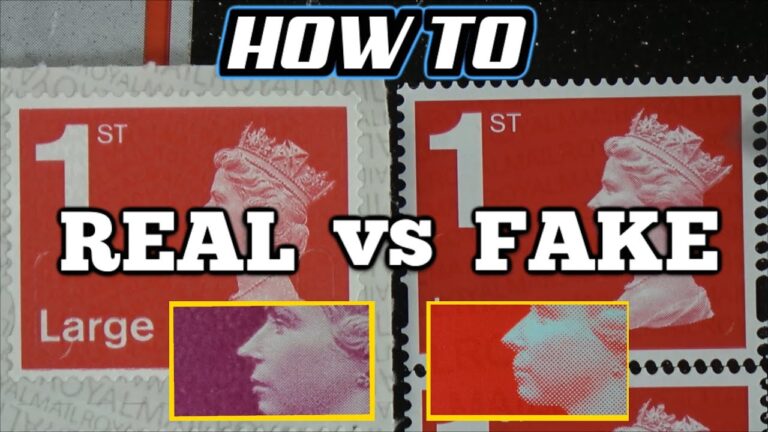Stamps have played a crucial role in the world of communication for centuries. Whether it's for sending letters or packages, these small adhesive pieces of paper have been a convenient method of paying for postal services. But how can you tell if a stamp has been used? It's important to be able to distinguish between unused and used stamps, especially for collectors or individuals looking to reuse stamps. There are several key indicators to look out for, including postmarks, cancellations, and overall condition. By examining these factors closely, you can determine whether a stamp has been previously used or remains in pristine condition. This article will delve into the various techniques and telltale signs to help you accurately identify if a stamp has been used, allowing you to make informed decisions when it comes to your stamp collection or postage needs.
- How does Royal Mail determine if a stamp has been utilized?
- Is Royal Mail able to determine if a stamp has been reused?
- Is it possible for them to determine if you have reused a stamp?
- Unveiling the Secrets: A Guide to Detecting Used Stamps
- Decoding the Signs: How to Identify If a Stamp Has Been Previously Used
- Unmasking Stamp Usage: Expert Tips on Spotting Used Stamps
- From Mint to Used: Unraveling the Mystery of Used Stamps
How does Royal Mail determine if a stamp has been utilized?
The Royal Mail now employs UV franking machines to determine if a stamp has been used. These machines can detect whether a stamp has already been through the mail system, even if it appears unused to the naked eye. In such cases, when a stamped item is sent for a second time, it will be flagged, and the recipient will be required to pay a fine at the local sorting office. This technology ensures that stamps are not reused, maintaining the integrity of the postal system.
The Royal Mail has introduced UV franking machines to prevent stamp reuse. These machines can identify if a stamp has already been used, even if it seems unused. In such instances, the recipient will have to pay a fine at the local sorting office when the item is sent again. This technology safeguards the postal system's integrity by ensuring stamps are not reused.
Is Royal Mail able to determine if a stamp has been reused?
Royal Mail has taken a significant step towards reducing stamp fraud by implementing barcodes on their stamps. This technological advancement allows the postal service to easily detect if a stamp has been reused. When a barcode is scanned at a sorting office, it immediately flags up if the barcode has been used before. This not only helps in preventing fraudulent activities but also ensures the integrity of the postage system. With this innovative solution, Royal Mail is effectively able to determine if a stamp has been reused, further enhancing their commitment to providing a secure and reliable postal service.
Royal Mail has implemented barcodes on their stamps as a measure to combat stamp fraud. By scanning the barcode at a sorting office, the system can quickly detect if the stamp has been reused before, thus maintaining the integrity of the postage system and preventing fraudulent activities. This innovative solution reinforces Royal Mail's commitment to providing a secure and reliable postal service.
Is it possible for them to determine if you have reused a stamp?
In the world of stamp collecting, experts possess the ability to determine whether a stamp has been reused or not, despite the removal of a post mark or cancellation. By carefully examining the stamp for any subtle alterations or signs of previous use, such as residual ink or faint impressions, they can identify any attempts to reuse a stamp. This level of scrutiny ensures the integrity of stamp collecting remains intact, preserving the historical value and authenticity of each individual stamp.
In the realm of philately, skilled collectors can distinguish whether a stamp has been recycled, even if the postmark or cancellation has been erased. Through meticulous examination, they detect subtle changes or remnants of previous use, such as ink residue or faint imprints, maintaining the credibility and historical significance of each stamp.
Unveiling the Secrets: A Guide to Detecting Used Stamps
Unveiling the Secrets: A Guide to Detecting Used Stamps
In the world of stamp collecting, uncovering the mysteries behind used stamps can be an exhilarating journey. This guide aims to equip collectors with the necessary tools to identify the signs of a used stamp, distinguishing them from the pristine ones. By examining the condition, cancellation marks, and postmarks, one can unravel the story behind each stamp. Whether it's a rare find or a common treasure, understanding the secrets of used stamps adds depth and intrigue to any collection. Embark on this fascinating adventure and unlock the hidden history within these tiny pieces of art.
Becoming skilled at detecting used stamps is an essential skill for collectors. By carefully examining factors such as condition, cancellation marks, and postmarks, collectors can uncover the hidden stories behind each stamp. This knowledge adds depth and intrigue to any collection, whether it's a rare find or a common treasure. Embark on this fascinating adventure and unlock the secrets within these tiny pieces of art.
Decoding the Signs: How to Identify If a Stamp Has Been Previously Used
Decoding the signs of a previously used stamp can be a challenging task for collectors and enthusiasts. One of the most obvious indicators is the absence of gum, the adhesive layer on the back of the stamp. Other telltale signs include traces of cancellation marks, such as ink or pen marks, or the presence of a hinge mark, where the stamp was previously attached to an album. Additionally, a faded or smudged postmark might suggest that the stamp has been used before. Paying attention to these signs can help collectors ensure the authenticity and value of their stamp collection.
Identifying a previously used stamp can be a challenging task for collectors. Absence of gum, cancellation marks, hinge marks, and faded postmarks are all indicators of a stamp's previous use. These signs are crucial in determining the authenticity and value of a stamp collection.
Unmasking Stamp Usage: Expert Tips on Spotting Used Stamps
When it comes to collecting stamps, identifying used stamps can be a tricky task. However, with expert tips, you can become adept at spotting them. One crucial aspect to consider is the cancellation mark, which indicates that the stamp has been used. This mark can vary in style and can be found in different locations on the stamp. Another important factor is the condition of the stamp. Used stamps may show signs of wear and tear, such as creases or fading. By paying attention to these details, you can unmask the true nature of stamps and enhance your collection.
Identifying used stamps can be difficult, but by focusing on the cancellation mark and the condition of the stamp, collectors can become skilled at spotting them. The cancellation mark varies in style and location, while signs of wear and tear, like creases and fading, indicate that the stamp has been used. By paying attention to these details, stamp collectors can improve their collections.
From Mint to Used: Unraveling the Mystery of Used Stamps
When it comes to collecting stamps, the difference between mint and used ones can be quite intriguing. Mint stamps are those that have never been used and are in pristine condition, often sought after for their rarity and value. On the other hand, used stamps have been through the postal system and bear cancellation marks, which can provide insights into their history and usage. Collectors of used stamps often find joy in deciphering these marks, uncovering the stories behind them, and adding them to their collections.
Both mint and used stamps hold their own appeal for stamp collectors. Mint stamps are prized for their rarity and pristine condition, while used stamps offer insights into their history through cancellation marks. Collectors find joy in deciphering these marks and uncovering the stories behind them.
In conclusion, determining whether a stamp has been used can be a fascinating and rewarding endeavor for stamp collectors and enthusiasts alike. By carefully examining the various characteristics, such as cancellation marks, adhesive residue, and overall condition, one can gain valuable insights into a stamp's history and authenticity. However, it is important to note that while these indicators can provide strong evidence, they are not foolproof. Some clever forgers have become adept at replicating cancellation marks and other signs of usage. Therefore, it is essential to consult expert advice or utilize advanced tools, such as ultraviolet light, to further verify a stamp's legitimacy. Nonetheless, the joy of uncovering a genuinely used stamp, with all its intricate details and historical significance, is an unparalleled experience that continues to captivate collectors worldwide. So, whether you are a novice or a seasoned philatelist, delving into the world of used stamps can be a fascinating journey that combines art, history, and detective work into a truly remarkable hobby.
Si quieres conocer otros artículos parecidos a Stamp of Truth: Unveiling the Secrets of Used Stamps puedes visitar la categoría History.

